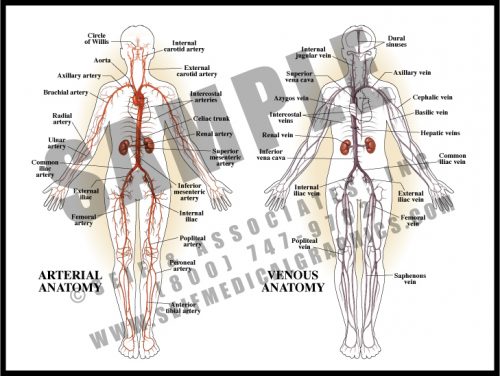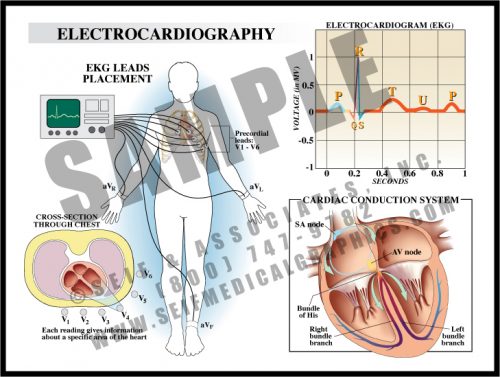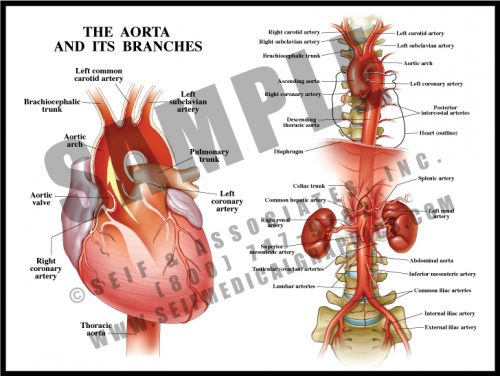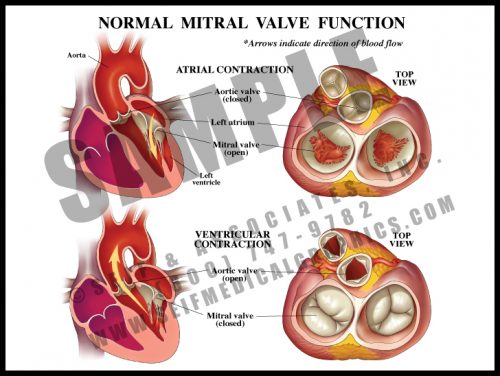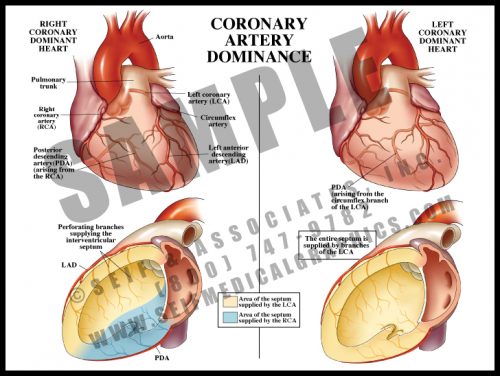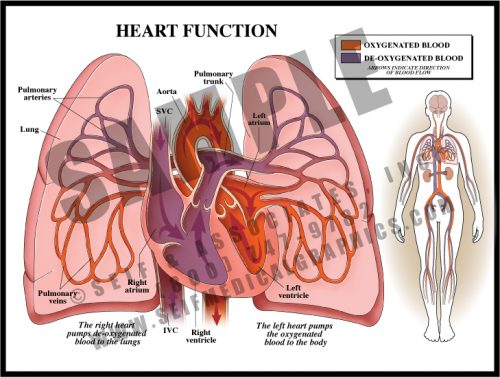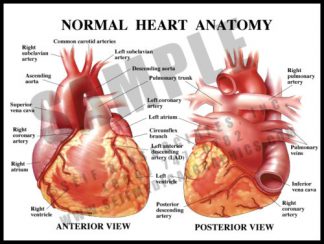- Although the cardiovascular system is referred to as one unit, it is actually two separate systems which work independently.
- Through the arterial supply, oxygenated blood is distributed from the lungs to the left heart and aorta, and eventually to within 5 cells of every cell in the body. The arteries divide into smaller arteries, then into arterioles, which in turn divide into capillaries. Oxygen exchange takes place at the level of the capillaries, vessels whose walls are only one cell thick.
- In the venous system, deoxygenated blood drains from the capillaries, which conjoin into venules, small veins, veins, and the major draining vessels – the superior and inferior venae cavae. This blood then enters the right heart and travels to the lungs to re- oxygenate and start the cycle again.
-
-
- A tracing is made from electrical impulses traveling through the heart, tracking the way the heart muscle reacts to the conduction system.
- An electrical impulse is initiated at the sinoatrial node, passes through specialized neuromuscular fibers lying beneath the inner lining of the heart until it reaches the atrioventricular node; from there, it travels through the Bundle of His, into the bundle branches and the Purkinje fibers, stimulating ventricular contraction.
- Changes in tracings are evaluated by comparing them to normal and/or baseline tracings; a physician can get information about areas of heart damage, both acute and chronic.
-
- The largest artery in the body, the aorta leaves the left ventricle and supplies all of the body’s tissues, including the heart itself, via its branches.
- The major parts are the arch (from the aortic valve to the left subclavian artery), descending thoracic aorta (from the left subclavian to the diaphragm) and abdominal aorta (from the diaphragm to the iliac bifurcation at about the level of the umbilicus).
- There are three major vessels leaving the arch and these supply the head, neck and arms; there are segmental vessels supplying the body wall throughout the length of the aorta. Major branches supply abdominal structures; the iliac arteries and their branches supply the pelvis and legs.
-
- A pulmonary embolism is a blockage in one or more arteries of the lungs. In most cases, it is caused by clots that travel to the lungs from another part of the body, most commonly from a DVT in a lower extremity.
- Depending on the size of the embolus, it can occlude the main pulmonary artery, straddle the arterial bifurcation, or dis- seminate out into the smaller branching arteries of the lungs.
- Saddle embolisms are frequently fatal, while embolic showers can be clinically silent unless they block enough of the pulmonary vasculature.
-
- Also known as the left atrioventricular valve, the mitral valve has 2 leaflets which are anchored to the ventricle floor by papillary muscles and chordae tendinae, as are the leaflets of the right atrioventricular valve (tricuspid valve).
- The aortic and pulmonary (pulmonic) valves are semilunar valves, and have thin cusps with thickened edges which seal during diastole (when the ventricles are relaxed and blood flows into the atria).
- The mitral valve prevents backflow from the left ventricle into the atrium; minor mitral valve prolapse or leak is usually clinically insignificant.
-
- Right heart dominance: the posterior portion of the interventricular septum is supplied by the posterior descending branch of the right coronary artery.
- Left heart dominance: the entire septum is supplied by branches of the left anterior descending artery; an obstruction in that vessel may lead to loss of the entire septum, an often fatal event. The posterior descending artery is derived from a branch of the circumflex artery instead of from the RCA.
-
- The normal heart is really two separate pumps working in tandem; there is no connection between the right and left sides in the normal post-fetal heart.
- The right heart receives de-oxygenated blood from the body, moving it from the right atrium to the right ventricle to the lungs via the pulmonary artery. Carbon dioxide is released and oxygen is picked up in the lungs.
- The left heart receives oxygenated blood from the lungs, moving it from the left atrium to the left ventricle, and from there to the aorta, which distributes it to the rest of the body.
- The ventricles are thick muscular chambers which move blood with each contraction; the average left ventricle contracts with a force of 120 mmHg.
-
- Heart muscle is supplied by the coronary arteries, not by the blood flowing through the heart.
- The major coronary vessels are the right coronary artery (RCA) and left main coronary artery (LCA), both of which come directly off of the aorta via the coronary ostia.
- The LCA divides into the left anterior descending artery(LAD) and circumflex artery.
- The RCA has no major branches, and terminates as the posterior descending artery (PDA).
- There are may be variations in the anatomy.
